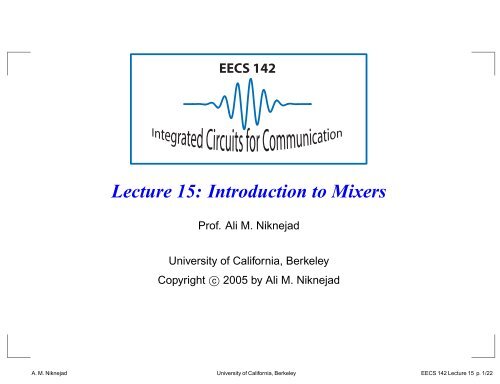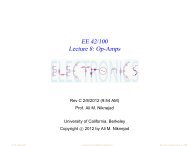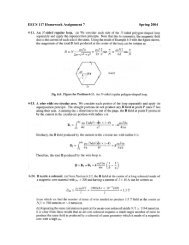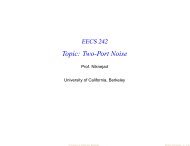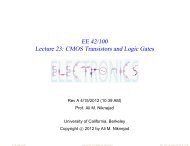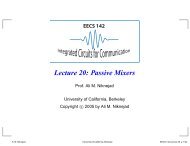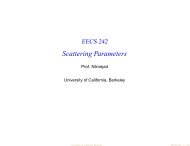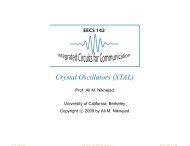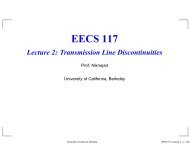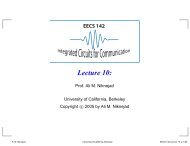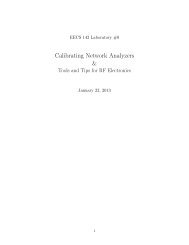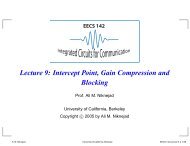Lecture 15: Introduction to Mixers - Ali M. Niknejad - University of ...
Lecture 15: Introduction to Mixers - Ali M. Niknejad - University of ...
Lecture 15: Introduction to Mixers - Ali M. Niknejad - University of ...
Create successful ePaper yourself
Turn your PDF publications into a flip-book with our unique Google optimized e-Paper software.
Frequency Translationdown-conversionIFIFRFLOAs shown above, an ideal mixer translates themodulation around one carrier <strong>to</strong> another. In a receiver,this is usually from a higher RF frequency <strong>to</strong> a lower IFfrequency. In a transmitter, it’s the inverse.We know that an LTI circuit cannot perform frequencytranslation. <strong>Mixers</strong> can be realized with eithertime-varying circuits or non-linear circuitsA. M. <strong>Niknejad</strong> <strong>University</strong> <strong>of</strong> California, Berkeley EECS 142 <strong>Lecture</strong> <strong>15</strong> p. 3/22
Ideal MultiplierSuppose that the input <strong>of</strong> the mixer is the RF and LOsignalv RF = A(t) cos (ω 0 t + φ(t))v LO = A LO cos (ω L0 t)Recall the trigonometric identitycos(A + B) = cosAcos B − sin A sin BApplying the identity, we havev out= v RF × v LO= A(t)A LO{cos φ (cos(ω LO + ω 0 )t + cos(ω LO − ω 0 )t)2− sin φ (sin(ω LO + ω 0 )t + sin(ω LO − ω 0 )t)}A. M. <strong>Niknejad</strong> <strong>University</strong> <strong>of</strong> California, Berkeley EECS 142 <strong>Lecture</strong> <strong>15</strong> p. 4/22
Mixer + FilterLO-RFRFLOLO+RFNote that the LO can be below the RF (lower sideinjection) or above the RF (high side injection)Also note that for a given LO, energy at LO ± IF isconverted <strong>to</strong> the same IF frequency. This is a potentialproblem!A. M. <strong>Niknejad</strong> <strong>University</strong> <strong>of</strong> California, Berkeley EECS 142 <strong>Lecture</strong> <strong>15</strong> p. 6/22
Upper/Lower Injection and ImageExample: Downconversion MixerRF = 1GHz = 1000MHzIF = 100MHzLet’s say we choose a low-side injection:LO = 900MHzThat means that any signals or noise at 800MHz willalso be downconverted <strong>to</strong> the same IFA. M. <strong>Niknejad</strong> <strong>University</strong> <strong>of</strong> California, Berkeley EECS 142 <strong>Lecture</strong> <strong>15</strong> p. 7/22
Receiver ApplicationRF+IMAGEIFLNALOThe image frequency is the second frequency that alsodown-converts <strong>to</strong> the same IF. This is undesirablebecuase the noise and interferance at the imagefrequency can potentially overwhelm the receiver.One solution is <strong>to</strong> filter the image band. This places arestriction on the selection <strong>of</strong> the IF frequency due <strong>to</strong>the required filter QA. M. <strong>Niknejad</strong> <strong>University</strong> <strong>of</strong> California, Berkeley EECS 142 <strong>Lecture</strong> <strong>15</strong> p. 8/22
Image RejectionIMAGE REJECTRF+IMAGEIFLNALOSuppose that RF = 1000MHz, and IF = 1MHz. Thenthe required filter bandwidth is much smaller than 2MHz<strong>to</strong> knock down the image.In general, the filter Q is given byQ = ω 0BW = RFBWA. M. <strong>Niknejad</strong> <strong>University</strong> <strong>of</strong> California, Berkeley EECS 142 <strong>Lecture</strong> <strong>15</strong> p. 9/22
Image Reject FilterIn our example, RF = 1000MHz, and IF = 1MHz. TheImagine is on 2IF = 2MHz away.Let’s design a filter with f 0 = 1000MHz andf 1 = 1001MHz.A fifth-order Chebyshev filter with 0.2 dB ripple is downabout 80 dB at the IF frequency.But the Q for such a filter isQ = 103 MHz1MHz = 103Such a filter requires components with Q > 10 3 !A. M. <strong>Niknejad</strong> <strong>University</strong> <strong>of</strong> California, Berkeley EECS 142 <strong>Lecture</strong> <strong>15</strong> p. 10/22
RF FilteringIF 1IF 2LNALO 1LO 2The fact that the required filter Q is so high is related <strong>to</strong>the problem <strong>of</strong> filtering interferers. The very reason wechoose the superheterodyne architecture is <strong>to</strong> simplifythe filtering problem. It’s much easier <strong>to</strong> filter a fixed IFthan filter a variable RF.The image filtering problem can be relaxed by usingmulti-IF stages. Instead <strong>of</strong> moving <strong>to</strong> such a low IFwhere the image filtering is difficult (or expensive andbulky), we down-convert twice, using successively lowerIF frequencies.A. M. <strong>Niknejad</strong> <strong>University</strong> <strong>of</strong> California, Berkeley EECS 142 <strong>Lecture</strong> <strong>15</strong> p. 11/22
Direct Conversion ReceiverRFIF=DCLO leakageLNALO=RFA mixer will frequency translate two frequencies,LO ± IFWhy not simply down-convert directly <strong>to</strong> DC? Anotherwords, why not pick a zero IF?This is the basis <strong>of</strong> the direct conversion architecture.There are some potential problems...A. M. <strong>Niknejad</strong> <strong>University</strong> <strong>of</strong> California, Berkeley EECS 142 <strong>Lecture</strong> <strong>15</strong> p. 12/22
Phase <strong>of</strong> LOIn a direction conversion system, the LO frequency isequal <strong>to</strong> the RF frequency.Consider an input voltage v(t) = A(t) cos(ω 0 t). Since theLO is generated “locally”, it’s phase is random relative<strong>to</strong> the RF input:v LO = A LO cos(ω 0 t + φ 0 )If we are so unlucky that φ 0 = 90 ◦ , then the output <strong>of</strong> themixer will be zero∫A(t)A LO sin(ω 0 t) cos(ω 0 t)dtT≈ A(t)A LO∫Tsin(ω 0 t) cos(ω 0 t)dt = 0A. M. <strong>Niknejad</strong> <strong>University</strong> <strong>of</strong> California, Berkeley EECS 142 <strong>Lecture</strong> <strong>15</strong> p. <strong>15</strong>/22
IQ-Mixercos(ω LO t)IRFQsin(ω LO t)To avoid this situation, we can phase lock the LO <strong>to</strong> theRF by transmitting a pilot <strong>to</strong>ne. Alternatively, we canuse two mixersAs we shall see, there are other benefits <strong>to</strong> such amixer.A. M. <strong>Niknejad</strong> <strong>University</strong> <strong>of</strong> California, Berkeley EECS 142 <strong>Lecture</strong> <strong>15</strong> p. 16/22
AM ModulationWe can see that an upconversion mixer is a naturalamplitude modula<strong>to</strong>rIf the input <strong>to</strong> the mixer is a baseband signal A(t), thenthe output is an AM carrierv o (t) = A(t) cos(ω LO t)How do we modulate the phase? A PLL is one way <strong>to</strong>do it. The IQ mixer is another way.Let’s expand a sinusoid that has AM and PMv o (t) = A(t) cos(ω 0 t + φ(t))= A(t) cosω 0 t cos φ(t) + A(t) sin ω 0 t sin φ(t)= I(t) cosω 0 t + Q(t) sin ω 0 tA. M. <strong>Niknejad</strong> <strong>University</strong> <strong>of</strong> California, Berkeley EECS 142 <strong>Lecture</strong> <strong>15</strong> p. 17/22
I-Q PlaneQφII(t) = A(t) cos φ(t)Q(t) = A(t) sin φ(t)We can draw a trajec<strong>to</strong>ry <strong>of</strong> points on the I-Q plane <strong>to</strong>represent different modulation schemes.The amplitude modulation is given byI 2 (t) + Q 2 (t) = A 2 (t)(cos 2 φ(t) + sin 2 φ(t)) = A 2 (t)A. M. <strong>Niknejad</strong> <strong>University</strong> <strong>of</strong> California, Berkeley EECS 142 <strong>Lecture</strong> <strong>15</strong> p. 18/22
General Modula<strong>to</strong>rThe phase modulation is given byQ(t)I(t)=sin φ(t)cosφ(t) = tanφ(t)or−1 Q(t)φ(t) = tanI(t)The IQ modula<strong>to</strong>r is a universal digital modula<strong>to</strong>r. Wecan draw a set <strong>of</strong> points in the IQ plane that representsymbols <strong>to</strong> transmit. For instance, if we transmitI = 0/A and Q = 0, then we have a simple ASK system(amplitude shift keying).A. M. <strong>Niknejad</strong> <strong>University</strong> <strong>of</strong> California, Berkeley EECS 142 <strong>Lecture</strong> <strong>15</strong> p. 19/22
Digital Modulation: BPSK/QPSKQQ0110I1000I11For instance, if we transmit I(t) = ±1, this representsone bit transmission per cycle. But since the I and Qare orthogonal signals, we can improve the efficiency <strong>of</strong>transmission by also transmitting symbols on the Q axis.If we select four points on a circle <strong>to</strong> represent 2 bits <strong>of</strong>information, then we have a constant envelopemodulation scheme.A. M. <strong>Niknejad</strong> <strong>University</strong> <strong>of</strong> California, Berkeley EECS 142 <strong>Lecture</strong> <strong>15</strong> p. 20/22
10.750.50.25-0.25-0.5-0.75-1Modulation Waveforms1 2 3 4 5 6The data wave form(left) is modulatedon<strong>to</strong> a carrier (below).The first plot showsa simple on/<strong>of</strong>f keying.The second plotshows binary phaseshift keying on onechannel (I).110.750.750.50.50.250.251 2 3 4 5 61 2 3 4 5 6-0.25-0.25-0.5-0.5-0.75-0.75-1-1A. M. <strong>Niknejad</strong> <strong>University</strong> <strong>of</strong> California, Berkeley EECS 142 <strong>Lecture</strong> <strong>15</strong> p. 21/22
More Bits Per CycleQQ011010001100000II101110111Eventually, the constellation points get very close<strong>to</strong>gether. Because <strong>of</strong> noise and dis<strong>to</strong>rtion, the receivedspectrum will not lie exactly on the constellation points,but instead they will form a cluster around such points.If the clusters run in<strong>to</strong> each other, errors will occur inthe transmission.We can increase the radius but that requires morepower.A. M. <strong>Niknejad</strong> <strong>University</strong> <strong>of</strong> California, Berkeley EECS 142 <strong>Lecture</strong> <strong>15</strong> p. 22/22


